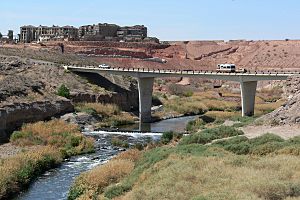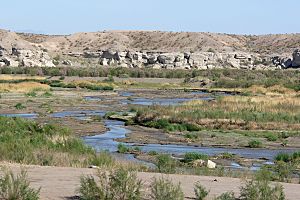Las Vegas Wash facts for kids
Quick facts for kids Las Vegas Wash |
|
|---|---|

Heavy flow in spring 2005, with Frenchman Mountain in the background
|
|
| Country | United States |
| State | Nevada |
| Region | Las Vegas Valley |
| Physical characteristics | |
| Main source | Lake Mead |
| River mouth | Las Vegas Bay |
| Length | 12 mi (19 km) |
The Las Vegas Wash is a 12-mile-long (about 19 km) waterway in Nevada. It carries most of the extra water from the Las Vegas Valley into Lake Mead. People sometimes call it an urban river because it exists mostly due to the city's growth.
It also works with the natural wetlands that were once an oasis in the Las Vegas Valley. The wash gets its water from several sources. These include urban runoff (water from streets), shallow groundwater, reclaimed water (treated wastewater), and stormwater (rainwater).
The wetlands around the Las Vegas Valley are very important. They act like the kidneys of the environment. They help clean the water that flows through them. These wetlands filter out harmful things like residues from fertilizers, oils, and other pollutants. These can often be found on roads and in the surrounding desert.
Near where it ends at Las Vegas Bay, the wash flows under the human-made Lake Las Vegas. It goes through two large 7-foot pipes to get there.
History of the Las Vegas Wash
Before many buildings and people came to the valley, the Las Vegas Wash was able to hold all the rainwater. But when the first sewage treatment plant started working, more water began flowing into the wash. This extra water caused the channel to get much wider. The increased flow also wore away the banks of the wash.
This wearing away, called erosion, also made the channel deeper. This caused one of the largest desert wetlands in the U.S. southwest to dry out. The water flowed quickly down the deeper channel instead of spreading out into the wetlands. This had several bad effects.
For example, more silt (fine dirt) flowed into Lake Mead. There were also fewer migratory birds visiting the area. The natural plants could no longer clean the water as well. Also, new plants that don't belong there, like African Tamarisk and Sahara Mustard, started to grow.
Water Sources for the Wash
The Las Vegas Wash gets its water from several important natural sources. These sources help keep the wash flowing.
Here are the main natural streams and channels that feed into the wash:
- Duck Creek
- Las Vegas Creek
- Flamingo Wash
- Pittman Wash
- Monson Channel
- Sloan Channel
- Meadows Detention Basin
- Tule Springs Wash



